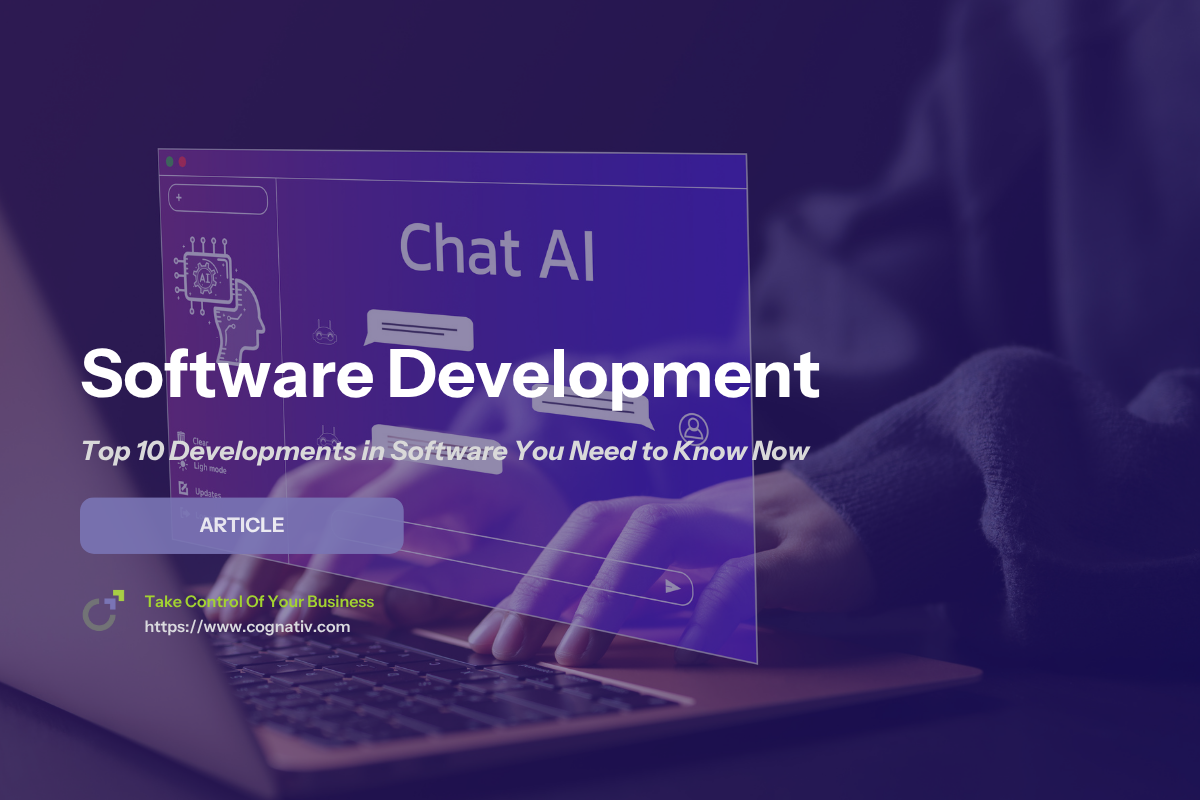Top 10 Software Development Trends You Need to Know Now
What are the most important developments in software today? In this article, we explore the top 10 advancements reshaping the software industry. From AI-driven development to enhanced security measures, discover how these trends are changing the way we build and use software.
Key Takeaways
-
AI-driven tools are streamlining software development, with 78% of developers already utilizing or planning to adopt them, enhancing code generation, review, and testing.
-
The rise of low-code and no-code platforms is democratizing software development, with predictions that 70% of new business applications will utilize these technologies by 2025.
-
Enhanced security measures are crucial in modern software development, with practices like DevSecOps and AI integration being essential for safeguarding applications throughout their lifecycle.
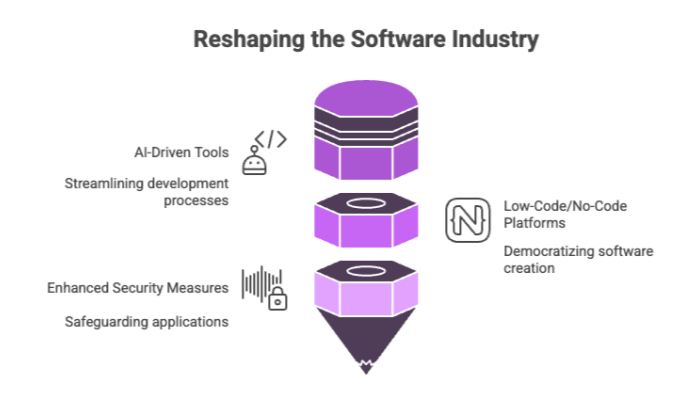

AI-Driven Software Development
Artificial Intelligence (AI) is no longer just a buzzword; it’s a cornerstone of modern software development. AI tools are now integral in generating new code, reviewing existing code, and testing applications. This speeds up development and reduces human error. Imagine a world where generative AI suggests optimizations and identifies potential errors during the code review process. This is not a distant future—it’s the present.
Generative AI tools are also making waves by translating code between different programming languages, saving valuable time and reducing errors. This allows software developers to focus on creative problem-solving instead of mundane translation tasks. The adoption of AI facilitates faster innovation cycles by enabling teams to test and deploy changes rapidly. Currently, 78% of developers are either using AI tools or planning to adopt them within the next two years.
AI’s future in software development appears even more promising. AI could automate code debugging before shipping, optimize CI/CD pipelines, and enhance quality assurance. Machine learning algorithms predict project risks and improve planning accuracy, making development more efficient and reliable. The software has been rigorously tested to ensure its effectiveness.
As AI evolves, its expanding role in software projects will drive further development in the field.
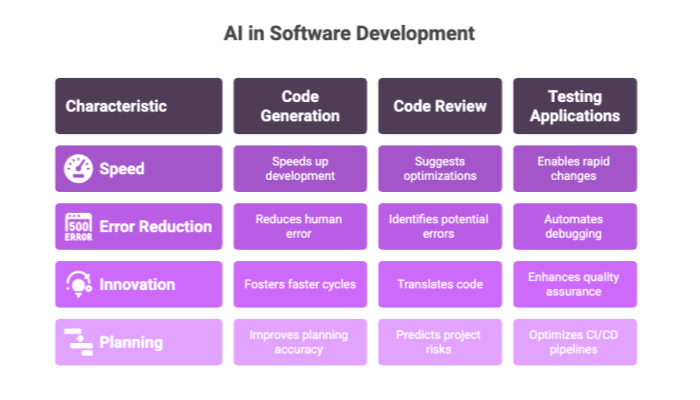

The Rise of Low-Code and No-Code Platforms
Low-code and no-code platforms are transforming software development. These platforms allow businesses to build applications without requiring extensive IT resources, making developing software more accessible to non-developers. By 2025, about 70% of new business applications are expected to use low-code or no-code technologies. This democratizes software development, enabling more people to contribute to projects.
The benefits of low-code platforms are substantial. Companies adopting these solutions are seeing an average revenue increase of 58% from customer-facing applications. Low-code platforms can also reduce app development time by up to 90%. This rapid development cycle is crucial for businesses looking to stay competitive in a fast-paced market. The low-code market is expected to reach $187 billion by 2030, highlighting its rapid growth and adoption.
A key aspect of low-code platforms is the empowerment of citizen developers. By 2024, 80% of technology products and services are expected to create developing by non-developer, following a new development model in several ways. This could result in a four-to-one ratio of citizen developers to professional developers by 2025.
The rise of low-code and no-code platforms represents a fundamental change in new software development, making it more inclusive and efficient.
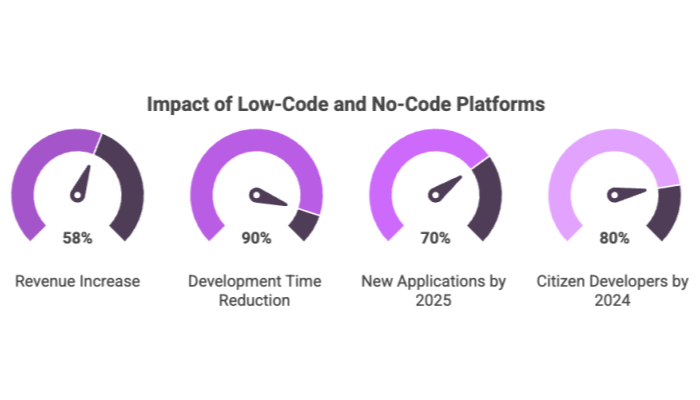

Cloud-Native Development Trends
Cloud-native development is redefining software development standards. Moving beyond mere cloud computing deployment, it encompasses practices like containerization, Infrastructure as Code (IaC), and serverless architectures. These technologies are becoming the norm for new applications, enabling better scalability and agility in the development process. The microservices architecture, adopted by 85% of large organizations, underscores this trend.
Kubernetes is crucial for managing microservices architecture complexities. Modern CI/CD pipelines automate code changes, testing, and deployment in cloud-native environments. This automation boosts efficiency, letting teams focus on new features instead of manual deployment tasks. Continuous deployment processes let DevOps teams automate updates and patches, significantly enhancing efficiency.
The move to cloud-native development is driven by the need for faster, more resilient, and scalable applications. As businesses continue to migrate to the cloud, understanding and implementing these practices will be essential for staying competitive. The cloud-native approach involves adopting a mindset that prioritizes flexibility, automation, and efficiency.
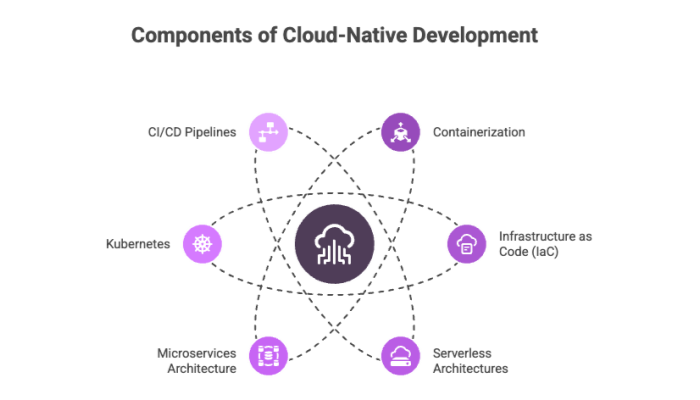

Embedded Systems Development Advances
Embedded systems development is changing significantly, driven largely by IoT integration. This integration influences the design and functionality of embedded systems, making them more interconnected and intelligent. Cybersecurity has become a fundamental requirement in embedded systems development. The rise of DevSecOps principles and tools is crucial here.
DevSecOps practices embed security into each development step, unlike traditional DevOps. This approach is gaining traction in embedded and IoT systems development, ensuring security is a core component from the start. The advancements in IoT integration and the rise of DevSecOps are essential for the secure development of embedded systems.
These developments represent a shift in how embedded systems are perceived and developed, not just technical upgrades. Focused on security and IoT integration ensures that embedded systems are functional, secure, and future-proof. As demand for smarter, more secure systems grows, these advancements will help us understand those needs, making investment in technology essential.
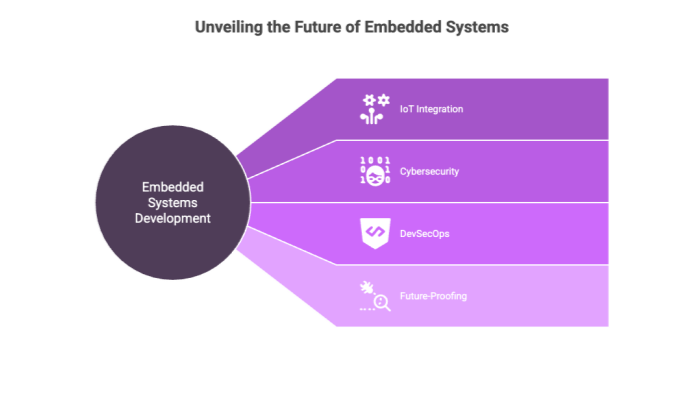

Enhanced Security Measures in Software Development
Security is paramount in today’s software development landscape. DevSecOps integrates security throughout the software development lifecycle, enhancing safety and reliability. AI enhances the speed and efficiency of handling security threats in this integration. AI can provide real-time monitoring to detect suspicious behavior within applications, adding extra security.
AI’s predictive analysis can forecast potential security threats based on existing data, enabling proactive measures. AI can also streamline compliance by automating security policy checks throughout the development process, ensuring that software projects meet high standards of security. Automated security testing tools can detect vulnerabilities before applications are deployed.
These measures are essential for protecting software projects from emerging threats. Integrating security into every development step ensures applications are functional and secure. Combining DevSecOps with AI-enhanced security tools advances software safeguarding in a complex digital landscape.
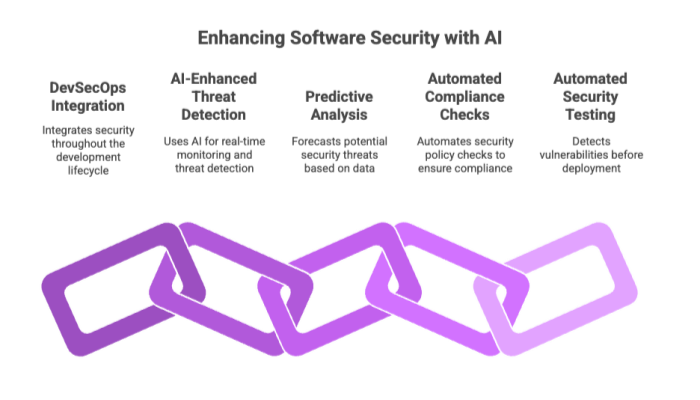

Progressive Web Apps (PWAs) and User Experience
Progressive Web Apps (PWAs) are changing how businesses approach application development. PWAs combine the best features of traditional websites and native mobile apps, offering a seamless user experience across devices. A key advantage of PWAs is their speed—while the average load time for a mobile website is around 8 seconds, PWAs can load in under a second.
PWAs work efficiently even in areas with poor internet connectivity, providing offline functionality. This makes them ideal for users in regions with unreliable internet access. Push notifications from PWAs help businesses re-engage users and improve customer retention. PWA development is also cost-effective, often significantly cheaper than creating separate native apps for iOS and Android.
The rise of PWAs signifies a shift towards more efficient, user-friendly application development. With faster load times, offline availability, and cross-platform compatibility, PWAs enhance user experience and offer a cost-effective solution for businesses. As more organizations adopt PWAs, they will shape the future of application development.
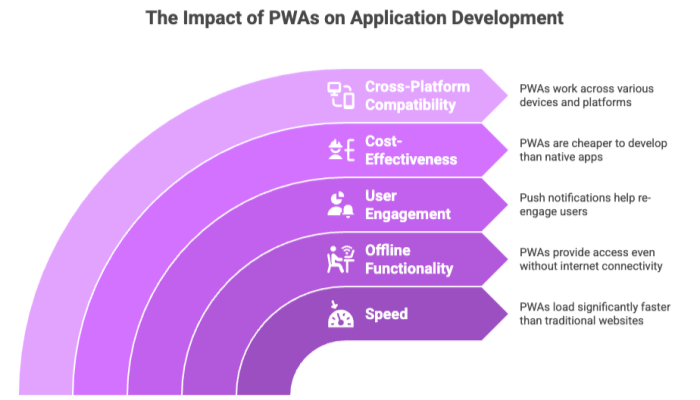

Blockchain Technology in Software Projects
Blockchain technology is gaining traction in software development. Its decentralization and data replication significantly improve data security, making it attractive for various industries. Smart contracts, a key feature of blockchain, automate processes and reduce the need for intermediaries, enhancing efficiency.
The blockchain market is expected to grow to $291 billion by 2030, showing a robust increase in demand and application. This growth is driven by blockchain’s ability to provide enhanced security and transparency. 73% of executives believe integrating blockchain into their operations can give them a competitive advantage.
As blockchain evolves, its applications in software projects will expand. Blockchain offers numerous benefits, from improving data security to automating processes, that can revolutionize software development. Its growing adoption across various sectors highlights its potential to transform software project management and execution.
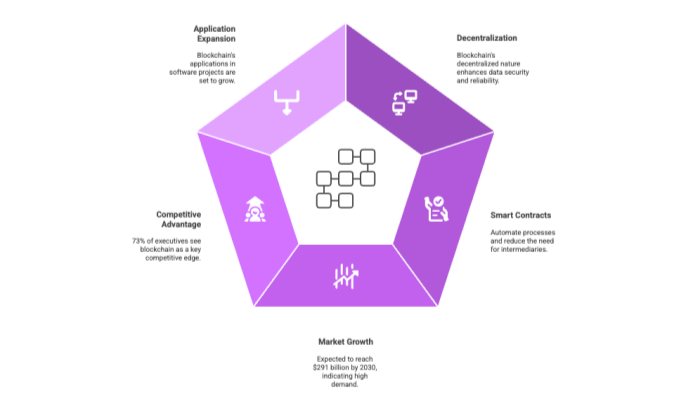

The Popularity of Rust Programming Language
The Rust programming language is quickly gaining popularity among developers. Known for its speed, security, and performance, Rust has become a preferred choice. In 2023, 93% of survey respondents identified as Rust users, reflecting its widespread adoption. Notable companies like Facebook, Dropbox, and Amazon use Rust in production, showcasing its trustworthiness.
Searches for Rust have increased by 48% over the past five years, indicating growing interest. Rust moved up 18 spots on the Tiobe popularity index, further highlighting its growing recognition. The Rust Foundation, established in early 2021, plays a crucial role in fostering Rust’s development.
The rise of Rust signifies a shift towards more secure and efficient programming languages. Its growing popularity among developers and adoption by major companies underscore its potential to shape software development’s future, reducing the risk of common vulnerabilities. As more developers embrace Rust, its influence on the industry will grow.
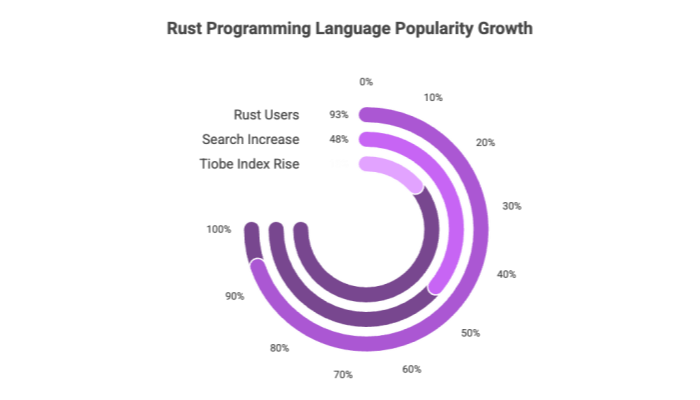

Outsourcing Trends Amid IT Skill Shortages
The IT industry faces a significant talent shortage, with 64% of executives considering it the biggest barrier to technology adoption. There are an estimated 85 million unfilled jobs by 2030 due to the talent shortage. This has led to increased outsourcing as businesses seek to augment their workforce and reduce costs.
Outsourcing IT roles helps businesses tap into a global talent pool, providing access to expertise and knowledge that may be lacking in-house. Eighty percent of HR professionals are now open to hiring self-taught individuals or those trained in bootcamp-style courses, reflecting a shift in hiring practices and service. This trend is crucial for businesses looking to stay competitive and adapt to the evolving job market.
Despite benefits, outsourcing can lead to high turnover as skilled employees seek better opportunities. For many businesses, the advantages of outsourcing, such as cost reduction and access to specialized skills, outweigh the drawbacks. As the talent shortage persists, outsourcing will continue to be a vital strategy for businesses navigating the challenges of the modern IT landscape.
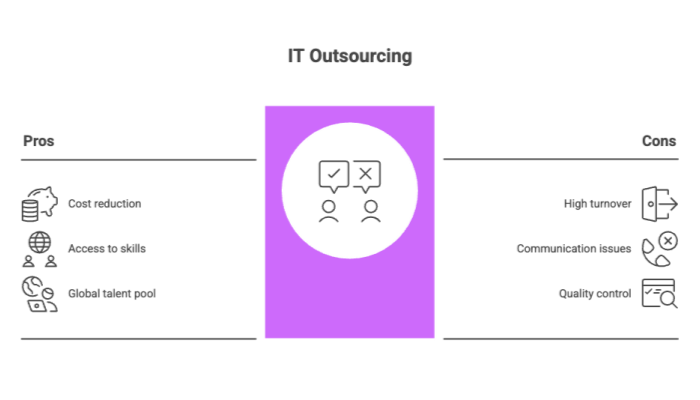

Agile Development and Continuous Improvement
Agile development and continuous improvement are cornerstones of modern software development. Agile methodologies emphasize regular retrospectives to discuss successes and areas for improvement, fostering a culture of continuous enhancement. The PDCA cycle (Plan-Do-Check-Act) is a foundational tool for continuous improvement, helping teams systematically approach changes using an iterative approach.
Engaging employees in the continuous improvement process can enhance their involvement and satisfaction within the organization. Frequent performance reviews and capturing ideas for improvement are best practices that support ongoing development and efficiency. Companies like Amazon exemplify continuous improvement by utilizing lean methodologies to optimize operations and focus on customer satisfaction.
The principles of agile development and continuous improvement lead to better software projects and enhanced team performance. By fostering a culture of constant evaluation and adaptation, organizations can achieve their business objectives and maintain a competitive advantage. As these practices become more ingrained in the software development process, their impact on the industry will continue to grow.
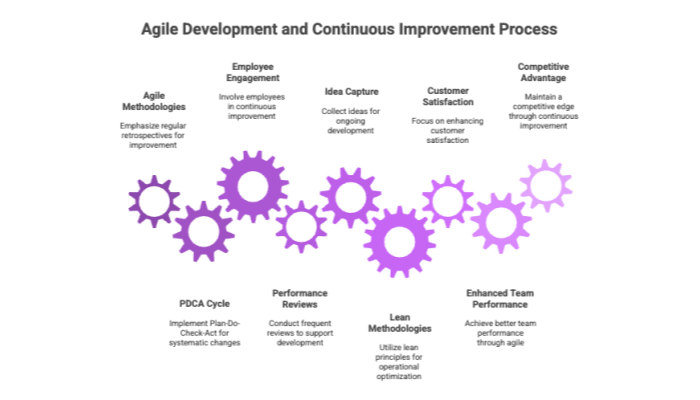

Summary
The rapid pace of innovation in software development is driving significant advancements across various areas. From AI-driven processes to the rise of low-code platforms, cloud-native development, and enhanced security measures, these trends are shaping the future of software projects.
The integration of blockchain technology, the popularity of Rust, and the shifting landscape of outsourcing further highlight the dynamic nature of the industry. As businesses continue to adopt agile development and continuous improvement practices, they will be better equipped to navigate the challenges and opportunities of the modern software landscape.
Staying informed about these developments is crucial for anyone involved in software development, ensuring they remain competitive and innovative in an ever-evolving field.

Frequently Asked Questions
Here are answers to some of the most common questions about the latest developments in software. This FAQ section provides quick insights into how emerging technologies and trends are shaping the software development landscape today.
How is AI transforming software development?
AI is transforming software development by automating code generation and review, streamlining continuous deployment, and predicting project risks, ultimately improving efficiency and reducing errors throughout the development process.
What are the benefits of low-code and no-code platforms?
Low-code and no-code platforms drastically reduce app development time by up to 90% and lower costs, while enabling non-developers to contribute to software projects, fostering inclusivity in the development process.
Why is cloud-native development becoming the standard?
Cloud-native development is becoming the standard due to its ability to enhance scalability, agility, and efficiency through practices like containerization and microservices architecture. These methodologies establish a new benchmark for software development and deployment.
How do DevSecOps and AI enhance security in software development?
DevSecOps enhances security by embedding it throughout the software development lifecycle, while AI advances this by offering real-time monitoring and predictive analysis to quickly address security threats. Together, they create a robust framework that ensures high standards of security are maintained.
Why is Rust becoming a popular programming language?
Rust is becoming popular due to its exceptional speed, security, and performance, leading to increased adoption by major companies and a notable rise on programming language indices. This trend indicates a strong preference among developers for Rust's capabilities.

